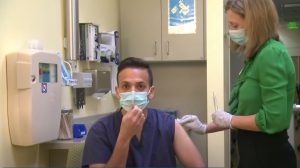NEW YORK (Reuters Health) – The incidence of venous thromboembolism in patients with advanced cancer is increased by about 33% during treatment with the angiogenesis inhibitor bevacizumab, the results of a meta-analysis indicate.
Bevacizumab (Avastin; Genentech Inc.), a monoclonal antibody against vascular endothelial growth factor, is widely used in cancer treatment, Dr. Shenhong Wu and co-authors note in the Journal of the American Medical Association for November 19. Several trials have revealed a higher incidence of venous thromboembolism associated with the drug, but sample sizes were too limited to show a statistically significant increase.
Dr. Wu’s group, based at the State University of New York at Stony Brook, identified 15 prospective randomized controlled trials that directly compared standard antineoplastic therapy with and without bevacizumab. A total of 7956 patients with a variety of advanced solid tumors were included in the analysis.
The summary relative risk associated with bevacizumab use was 1.29 (p = 0.03) for all-grade venous thromboembolism and 1.38 (p = 0.002) for high-grade venous thromboembolism.
Both high-dose (5 mg/kg per week) and lose-dose (2.5 mg/kg per week) bevacizumab were associated with significantly increased risk (RR = 1.31 for each).
“It is important for oncologists and primary care physicians to be aware of the increased incidence of venous thromboembolism associated with bevacizumab to monitor and treat it appropriately,” Dr. Wu and colleagues maintain. They even recommend adding a black box warning in the package insert to raise awareness among patients and their doctors.
The authors observed that the risk was greatest for patients with aerodigestive cancer and mesothelioma, leading them to suggest that these patients receive prophylactic treatment when using bevacizumab.
“In the event of venous thromboembolism,” the investigators advise, “anticoagulation is indicated, and bevacizumab may be continued if the benefits of the drug outweigh the risk.”
Reference:
JAMA 2008;300:2277-2285.




